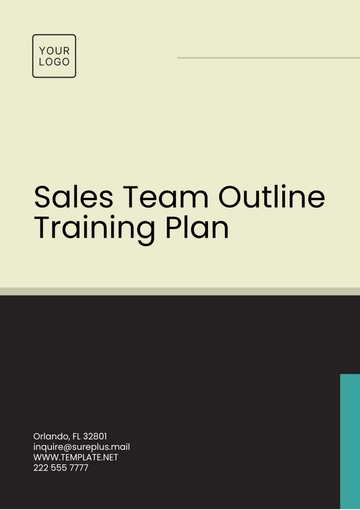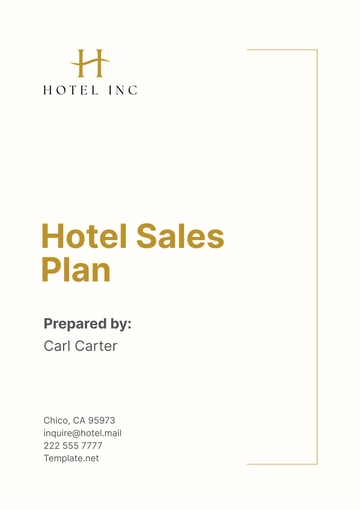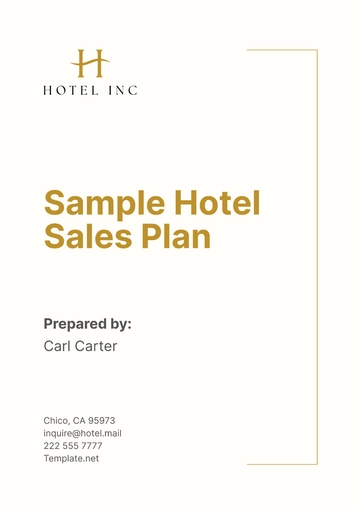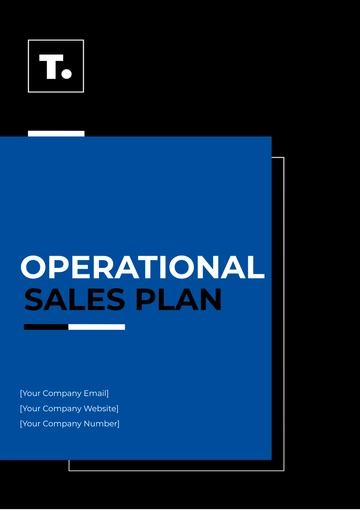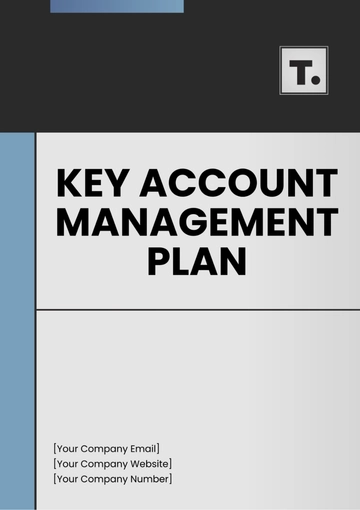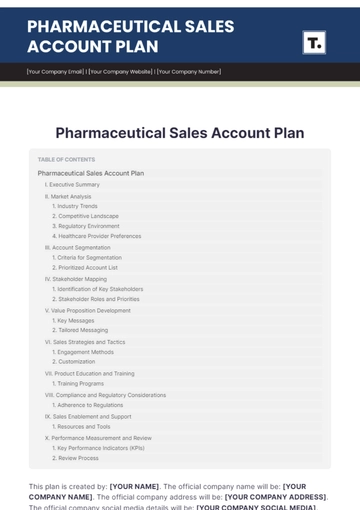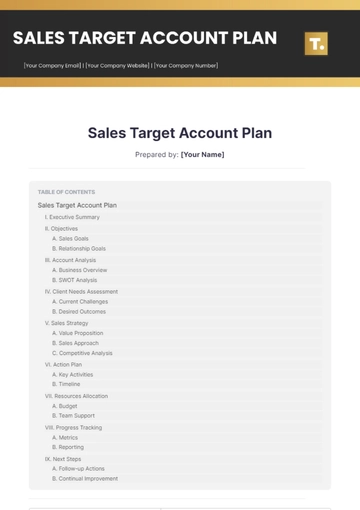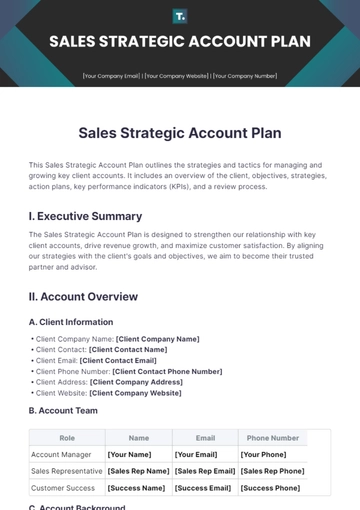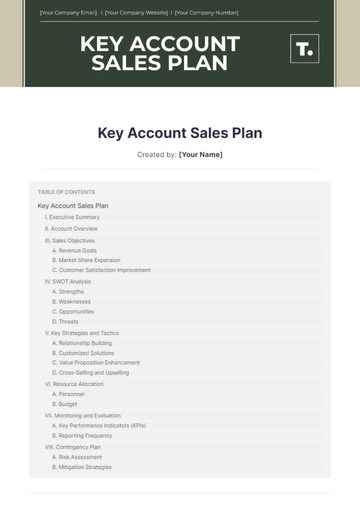Free Sales Management Plan for Deal Closing Teams

Deal Closing Teams
I. Introduction to Sales Management Plan for Deal Closing Teams
A. Overview
The Sales Management Plan for Deal Closing Teams serves as a strategic blueprint to optimize the deal closing process, foster collaboration among sales teams, and maximize revenue generation. It outlines a structured approach to managing sales operations, from lead acquisition to deal closure, ensuring efficiency and effectiveness throughout the sales cycle.
By implementing this plan, [Your Company Name] aims to streamline sales processes, enhance customer engagement, and achieve sustainable growth in the competitive [industry] market.
B. Purpose
The primary purpose of this Sales Management Plan is to:
a) Increase deal closure rate.
b) Improve sales team performance.
c) Enhance customer satisfaction.
d) Drive revenue growth.
C. Scope
This plan encompasses all activities related to the deal closing process, including lead management, opportunity analysis, proposal development, negotiation, and closing. It applies to all members of the deal closing teams within [Your Company Name].
II. Objectives and Key Results (OKRs)
A. Primary Objectives
Increase deal closure rate by [10%] within the next [quarter].
Enhance collaboration and communication among deal closing teams.
Improve sales forecasting accuracy by [15%] through data-driven insights.
B. Secondary Objectives
Reduce sales cycle time by [20%] through process optimization.
Enhance customer satisfaction by [10%] by providing personalized solutions.
Expand market reach by acquiring [X] number of new clients within the fiscal year.
C. Key Results
Table: Key Results Tracking
Objective | Key Result | Target | Actual |
|---|---|---|---|
Increase deal closure rate | Deal Closure Rate | [10%] | [0%] |
Enhance collaboration | Communication Effectiveness | [0%] | [0%] |
Improve forecasting | Forecasting Accuracy | [15%] | [0%] |
Reduce sales cycle time | Average Sales Cycle Time | [20%] | [0%] |
Enhance satisfaction | Customer Satisfaction Index (CSI) | [10%] | [0%] |
Expand market reach | New Client Acquisition | [0] | [0] |
The table above outlines the key results associated with each objective, along with the target and actual performance metrics. Tracking progress against these key results will enable [Your Company Name] to measure the effectiveness of the Sales Management Plan and make data-driven decisions for continuous improvement.
III. Sales Process Overview
A. Lead Management
Lead Acquisition:
Leads are acquired through various channels including inbound inquiries, outbound prospecting, marketing campaigns, and referrals.
The marketing team generates leads through digital marketing initiatives such as email campaigns, social media, and content marketing.
Sales representatives also actively prospect for leads through cold calling, networking events, and industry conferences.
Lead Qualification:
Leads are qualified based on predefined criteria including budget, authority, need, and timeline (BANT).
Qualification criteria are established in collaboration with sales and marketing teams to ensure alignment with target customer profiles.
Qualified leads are prioritized based on their readiness to buy and potential value to the organization.
Lead Assignment:
Qualified leads are assigned to deal closing teams based on territory allocation and specialization.
Assignment rules are set within the CRM system to automate lead distribution and ensure equitable workload distribution among sales representatives.
Regular lead routing and reassignment are conducted to optimize resource allocation and maximize conversion opportunities.
B. Opportunity Analysis
Customer Needs Assessment:
Sales representatives conduct thorough needs assessments to understand customer requirements, pain points, and objectives.
Consultative selling techniques are employed to uncover latent needs and provide tailored solutions that address specific customer challenges.
Customer-centric approach ensures that proposals and solutions are aligned with the unique needs and priorities of each prospect.
Stakeholder Mapping:
Key decision-makers and influencers within the prospect organization are identified and mapped to understand their roles, responsibilities, and priorities.
Relationship-building strategies are implemented to establish rapport and credibility with stakeholders at various levels of the organization.
Engaging with stakeholders early in the sales process helps to build trust and consensus, accelerating the decision-making process.
Competitive Analysis:
Comprehensive analysis of competitors' strengths, weaknesses, and market positioning is conducted to identify competitive advantages and differentiation strategies.
SWOT analysis (Strengths, Weaknesses, Opportunities, Threats) is performed to assess internal capabilities and external market dynamics.
Insights from competitive analysis inform pricing strategies, value propositions, and objection handling techniques during negotiations.
C. Proposal Development
Solution Customization:
Proposals are customized to address the specific needs and requirements identified during the opportunity analysis phase.
Collaboration with product specialists, engineers, and subject matter experts is essential to tailor solutions that meet customer expectations.
Value-based selling techniques are utilized to articulate the unique value proposition and ROI of the proposed solution.
Pricing Strategy:
Pricing strategies are developed based on value-based pricing principles, competitive benchmarking, and cost analysis.
Flexible pricing options and packaging are offered to accommodate varying customer budgets and preferences.
Transparent pricing ensures clarity and trust throughout the negotiation process, minimizing price objections and haggling.
Proposal Submission:
Proposals are prepared and submitted in a timely manner, adhering to customer deadlines and requirements.
Attention to detail is crucial to ensure accuracy and completeness of proposals, minimizing the risk of errors or discrepancies.
Proposal tracking mechanisms are implemented to monitor proposal status, follow-up activities, and next steps in the sales process.
IV. Sales Team Structure
A. Team Roles and Responsibilities
Sales Manager:
Provides leadership, direction, and support to the deal closing teams.
Sets sales targets, performance metrics, and KPIs in alignment with organizational goals.
Conducts regular performance reviews, coaching sessions, and training programs to develop sales skills and competencies.
Sales Representatives:
Engage with prospects to understand their needs and present tailored solutions.
Build and nurture relationships with key decision-makers and stakeholders.
Negotiate terms, overcome objections, and close deals to achieve sales targets.
B. Allocation of Territories
Geographic Territories:
Territories are defined based on geographical regions, industries, or customer segments.
Territory boundaries are established to ensure equitable distribution of leads and opportunities among sales representatives.
Regular territory reviews and adjustments are conducted to optimize coverage and maximize market penetration.
Lead Distribution:
Leads are distributed among sales representatives using predefined assignment rules within the CRM system.
Lead routing algorithms prioritize leads based on factors such as geographic proximity, sales specialization, and lead score.
Continuous monitoring and adjustment of lead distribution processes ensure fair and efficient allocation of resources.
Performance Monitoring:
Sales performance metrics are tracked at the individual, team, and territory levels to identify top performers and areas for improvement.
Dashboards and reports provide real-time visibility into key metrics such as deal closure rate, sales pipeline velocity, and revenue contribution.
Performance reviews and incentive programs are aligned with territory performance to incentivize achievement of sales targets and foster healthy competition.
III. Sales Process Overview
A. Lead Management
Lead Acquisition:
Leads are acquired through various channels, including:
Inbound inquiries via the website contact form and live chat.
Outbound prospecting through cold calling and email campaigns.
Marketing efforts such as webinars, events, and content marketing.
The marketing team generates leads through targeted campaigns aimed at specific market segments and buyer personas.
Sales representatives actively engage in prospecting activities to identify potential leads and opportunities.
Lead Qualification:
Leads are qualified based on the BANT (Budget, Authority, Need, Timeline) criteria to ensure they meet the qualification standards.
Qualification criteria are established collaboratively between sales and marketing teams to ensure alignment with the ideal customer profile.
Qualified leads are prioritized based on their likelihood to convert and their potential value to the organization.
Lead Assignment:
Qualified leads are assigned to deal closing teams using a lead routing system within the CRM platform.
Assignment rules consider factors such as sales territory, sales specialization, and workload distribution.
Regular lead assignment reviews are conducted to optimize the distribution process and ensure each lead receives prompt attention.
B. Opportunity Analysis
Customer Needs Assessment:
Sales representatives conduct thorough needs assessments during discovery calls and meetings with prospects.
Detailed questioning techniques are used to uncover pain points, challenges, and desired outcomes.
The information gathered during needs assessments informs the development of tailored solutions that address the prospect's specific requirements.
Stakeholder Mapping:
Key stakeholders within the prospect organization are identified and mapped to understand their roles, influence, and decision-making authority.
Relationship-building strategies are employed to establish rapport and credibility with stakeholders at different levels.
Engaging with stakeholders early in the sales process helps to navigate complex buying processes and secure buy-in from decision-makers.
Competitive Analysis:
A comprehensive analysis of competitors is conducted to understand their strengths, weaknesses, and market positioning.
Competitive intelligence is gathered through market research, competitor websites, and industry reports.
Insights from competitive analysis help to differentiate our offerings, anticipate objections, and tailor value propositions to highlight our unique advantages.
C. Proposal Development
Solution Customization:
Proposals are customized to address the specific needs and preferences identified during the opportunity analysis phase.
Collaboration with product specialists, engineers, and solution architects ensures that proposals are technically feasible and aligned with customer requirements.
Emphasis is placed on articulating the value proposition and ROI of the proposed solution to resonate with the prospect's business objectives.
Pricing Strategy:
Pricing strategies are developed based on a thorough understanding of the prospect's budget constraints, perceived value, and competitive landscape.
Flexible pricing options, such as tiered pricing and volume discounts, are offered to accommodate varying customer needs.
Transparent pricing ensures clarity and trust, facilitating constructive discussions and negotiations with the prospect.
Proposal Submission:
Proposals are prepared with meticulous attention to detail, ensuring accuracy, clarity, and alignment with the prospect's requirements.
Proposals are delivered in a timely manner, meeting the prospect's deadlines and expectations.
Follow-up activities are scheduled to address any questions or concerns raised by the prospect and to advance the proposal through the decision-making process.
IV. Sales Team Structure
A. Team Roles and Responsibilities
Sales Manager:
Provides leadership, coaching, and guidance to the deal closing teams.
Sets clear performance expectations and targets for individual team members.
Monitors sales performance metrics and provides feedback and support to improve performance.
Sales Representatives:
Engage with prospects to understand their needs and articulate the value proposition of our offerings.
Build and maintain relationships with key stakeholders throughout the sales process.
Negotiate terms, overcome objections, and close deals to achieve sales targets and revenue goals.
B. Allocation of Territories
Geographic Territories:
Sales territories are defined based on geographical regions, industries, or customer segments.
Territory boundaries are established to ensure equitable distribution of leads and opportunities among sales representatives.
Territories are periodically reviewed and adjusted based on market dynamics, sales performance, and business priorities.
Lead Distribution:
Leads are distributed among sales representatives using a fair and transparent lead assignment process.
Leads are prioritized based on factors such as lead score, prospect engagement, and sales readiness.
Regular monitoring and tracking of lead distribution ensure that leads are promptly followed up and no opportunities are overlooked.
Performance Monitoring:
Sales performance metrics are tracked and monitored regularly to assess individual and team performance.
Key performance indicators (KPIs) such as deal closure rate, sales pipeline velocity, and revenue contribution are used to evaluate performance.
Performance reviews are conducted periodically to provide feedback, identify areas for improvement, and recognize top performers.
V. Sales Performance Metrics
A. Key Performance Indicators (KPIs)
Deal Closure Rate:
The percentage of qualified leads that result in a successful sale.
Formula: (Number of Closed Deals / Number of Qualified Leads) * 100
Target: Achieve a deal closure rate of [60%] by the end of the quarter.
Average Sales Cycle Time:
The average duration from lead acquisition to deal closure.
Formula: Total Sales Cycle Time / Number of Closed Deals
Target: Reduce average sales cycle time to [30] days by implementing process improvements and automation.
Win-Loss Ratio:
The ratio of won deals to lost deals.
Formula: Number of Won Deals / Number of Lost Deals
Target: Maintain a win-loss ratio of at least [2:1] to demonstrate competitive strength and effectiveness in deal closing.
Revenue Generated:
The total revenue generated from closed deals within a specific period.
Formula: Sum of Revenue from Closed Deals
Target: Achieve a revenue target of [$00] by the end of the fiscal year.
B. Reporting and Analysis
Weekly/Monthly Sales Reports:
Generate regular sales reports to track KPIs and performance metrics.
Reports include metrics such as deal closure rate, average sales cycle time, win-loss ratio, and revenue generated.
Reports are distributed to sales managers, team leaders, and senior management for performance review and decision-making.
Sales Performance Reviews:
Conduct regular performance reviews with individual sales representatives and deal closing teams.
Review performance against targets, identify areas for improvement, and provide constructive feedback.
Performance reviews serve as an opportunity to recognize top performers and address performance gaps through training and coaching.
CRM Data Analysis:
Utilize data from the CRM system to analyze sales trends, pipeline velocity, and conversion rates.
Identify patterns and insights to forecast future sales, allocate resources effectively, and identify areas for process optimization.
Data-driven decision-making helps to improve sales performance and drive revenue growth.
VI. Training and Development
A. Continuous Training Programs
Product and Solution Training:
Provide ongoing training on [Your Company Name]'s products, services, and solutions.
Cover product features, benefits, use cases, and competitive positioning.
Training sessions are conducted regularly for new hires and existing sales representatives to ensure product knowledge is up-to-date.
Sales Techniques and Negotiation Skills:
Conduct workshops and seminars on sales techniques, objection handling, and negotiation skills.
Role-playing exercises and case studies are used to simulate real-world scenarios and practice effective sales strategies.
Training is tailored to address the specific needs and challenges faced by the sales team in the deal closing process.
Market and Industry Insights:
Keep sales teams informed about market trends, industry developments, and competitive landscape.
Provide access to industry reports, market analysis, and competitive intelligence.
Regular updates on market dynamics help sales representatives stay ahead of the curve and adapt their sales approach accordingly.
B. Coaching and Mentorship
Pairing with Experienced Mentors:
Pair new hires with experienced sales mentors to facilitate onboarding and knowledge transfer.
Mentors provide guidance, support, and practical advice based on their own experiences in deal closing.
Mentorship programs foster professional development and accelerate the learning curve for new sales representatives.
Performance Coaching:
Provide individualized coaching sessions to address performance issues and development areas.
Focus on improving sales techniques, communication skills, and confidence in dealing with customers.
Performance coaches work closely with sales representatives to set goals, track progress, and provide ongoing support.
Knowledge Sharing and Collaboration:
Encourage knowledge sharing and collaboration among sales teams through team meetings, forums, and brainstorming sessions.
Create a culture of collaboration where sales representatives can learn from each other's experiences and share best practices.
Foster a supportive environment where ideas are welcomed, and feedback is constructive, leading to continuous improvement in sales performance.
VII. Technology and Tools
A. CRM Implementation
Selection of CRM Software:
Evaluate different CRM platforms based on features, scalability, and integration capabilities.
Consider factors such as ease of use, customization options, and pricing.
Select a CRM solution that aligns with [Your Company Name]'s sales processes and business objectives.
Customization and Configuration:
Customize the CRM system to match the specific requirements of the deal closing teams.
Configure lead management workflows, opportunity stages, and sales pipeline views.
Integrate with other business systems such as marketing automation, finance, and customer support for seamless data flow.
Training and Adoption:
Provide comprehensive training to sales teams on how to use the CRM system effectively.
Offer hands-on workshops, online tutorials, and user guides to familiarize users with CRM features and functionalities.
Encourage adoption by highlighting the benefits of using the CRM system for tracking leads, managing opportunities, and improving collaboration.
B. Sales Enablement Tools
Integration of Sales Automation Tools:
Implement sales automation tools to streamline repetitive tasks and improve productivity.
Examples include email automation, document generation, and contract management solutions.
Integrate these tools with the CRM system to ensure data consistency and workflow efficiency.
Document Management Systems:
Utilize document management systems to centralize sales collateral, proposals, and contracts.
Ensure easy access to up-to-date sales materials for sales representatives to use during customer interactions.
Implement version control and access permissions to maintain document integrity and security.
Communication Platforms:
Deploy communication platforms such as instant messaging, video conferencing, and collaboration tools.
Facilitate real-time communication and collaboration among distributed sales teams.
Choose platforms that support file sharing, screen sharing, and team messaging to enhance teamwork and information sharing.
VIII. Budget and Resource Allocation
A. Budget Allocation
Allocate Resources for Training Programs:
Allocate a budget for conducting training programs, workshops, and certifications for sales teams.
Include expenses for hiring external trainers, purchasing training materials, and hosting training events.
Monitor training costs and ROI to ensure that investments in training yield tangible benefits in terms of improved sales performance.
Provision for Marketing Collateral and Promotional Activities:
Allocate funds for creating and distributing marketing collateral such as brochures, case studies, and presentations.
Budget for promotional activities such as trade shows, conferences, and advertising campaigns to generate leads and build brand awareness.
Track marketing expenses and evaluate their impact on lead generation and sales conversion rates.
Contingency Budget for Unexpected Expenses:
Set aside a contingency budget to cover unexpected expenses and emergencies.
Anticipate potential risks such as changes in market conditions, unexpected competitive threats, or unforeseen technical issues.
Maintain a buffer to ensure that the sales operation can adapt and respond effectively to unexpected challenges without disrupting business operations.
B. Resource Planning
Determine Staffing Requirements:
Assess current staffing levels and identify any gaps in sales team capacity.
Forecast future sales targets and workload to determine the optimal number of sales representatives needed.
Consider factors such as seasonality, product launches, and market expansion when planning staffing levels.
Allocate Resources Based on Territory Needs:
Allocate resources such as sales personnel, marketing support, and sales enablement tools based on territory needs and growth opportunities.
Prioritize territories with high potential for revenue generation and allocate resources accordingly.
Adjust resource allocation based on changes in market conditions, customer demand, and competitive dynamics.
Optimize Resource Utilization:
Continuously monitor resource utilization and performance metrics to identify areas for optimization.
Ensure that resources are allocated efficiently to maximize ROI and minimize waste.
Foster a culture of accountability and responsibility among sales teams to optimize resource utilization and drive results.
IX. Risk Management
A. Identification of Risks
Market Volatility and Economic Uncertainties:
Fluctuations in the economy, changes in market conditions, and geopolitical events may impact customer buying behavior and demand for products/services.
Mitigation Strategy: Diversify customer base across industries and geographic regions to reduce dependency on specific markets. Stay agile and responsive to changes in the business environment.
Competitive Pressures and Pricing Wars:
Intense competition within the industry may lead to price erosion, margin compression, and aggressive tactics from competitors.
Mitigation Strategy: Differentiate offerings based on value, quality, and customer service. Continuously monitor competitor activities and adjust pricing strategies accordingly to maintain competitiveness.
Technological Disruptions Impacting Sales Processes:
Rapid advancements in technology may render existing sales processes obsolete or less effective.
Mitigation Strategy: Stay abreast of emerging technologies and trends in sales automation, CRM, and digital marketing. Invest in training and upskilling programs to ensure sales teams are equipped to leverage new technologies effectively.
B. Mitigation Strategies
Diversification of Client Portfolio:
Expand customer base across multiple industries, market segments, and geographies to mitigate risks associated with concentration in specific sectors.
Regularly assess market trends and customer needs to identify new opportunities for diversification and expansion.
Regular Review of Pricing Strategies:
Monitor pricing trends, competitor pricing strategies, and customer willingness to pay to ensure pricing remains competitive and aligned with market dynamics.
Conduct periodic pricing reviews and adjustments based on changes in costs, demand, and competitive landscape.
Adoption of Agile Methodologies:
Embrace agile methodologies and iterative approaches to sales process improvement.
Foster a culture of innovation and experimentation, encouraging sales teams to test new ideas, adapt quickly to changes, and continuously improve processes.
X. Implementation Plan
A. Timeline
Phase-Wise Implementation Over [00] Months:
Phase 1:
Assess Current Processes and Identify Areas for Improvement
Phase 2:
Develop and Implement Sales Process Enhancements
Phase 3:
Roll Out Training and Development Programs
Phase 4:
Monitor Performance and Conduct Reviews
Milestones and Checkpoints:
Milestone 1:
Completion of Process Assessment and Gap Analysis
Milestone 2:
Implementation of CRM System and Sales Automation Tools
Milestone 3:
Completion of Sales Training Programs
Milestone 4:
Performance Review and Adjustment
Flexibility for Adjustments:
Build flexibility into the implementation plan to accommodate changes in priorities, resources, and external factors.
Regularly review progress against milestones and adjust timelines and objectives as needed to ensure successful implementation.
B. Responsibilities
Clearly Define Roles and Responsibilities:
Assign accountable individuals for each phase of the implementation plan.
Establish clear expectations and timelines for each role, ensuring alignment with overall objectives and deadlines.
Cross-Functional Collaboration:
Foster collaboration and communication among cross-functional teams involved in the implementation process.
Encourage open dialogue, information sharing, and teamwork to overcome challenges and drive progress.
Establish Communication Channels:
Set up regular meetings, status updates, and communication channels to keep stakeholders informed of progress and any issues that arise.
Provide avenues for feedback and input from all stakeholders to ensure their voices are heard and their concerns addressed.
XI. Evaluation and Monitoring
A. Performance Evaluation
Regular Assessment of Key Performance Indicators (KPIs):
Conduct ongoing monitoring and evaluation of KPIs such as deal closure rate, sales cycle time, win-loss ratio, and revenue generated.
Compare actual performance against targets set in the sales management plan to identify areas of strength and opportunities for improvement.
Post-Implementation Review:
After the completion of each phase of the implementation plan, conduct a thorough review to assess outcomes, identify lessons learned, and capture best practices.
Solicit feedback from sales teams, stakeholders, and customers to gather insights into the effectiveness of implemented changes and identify areas for further refinement.
Continuous Performance Reviews:
Establish a cadence for regular performance reviews, including monthly or quarterly meetings with sales teams to review progress, address challenges, and celebrate successes.
Use performance reviews as an opportunity to provide coaching, recognize achievements, and course-correct as needed to ensure alignment with strategic objectives.
B. Continuous Improvement
Implement Corrective Actions:
Based on performance analysis and feedback, implement corrective actions to address any identified gaps or deficiencies in the sales management process.
Develop action plans with specific steps, timelines, and responsible parties to address areas of improvement and drive positive change.
Review and Update Sales Management Plan:
Periodically review and update the sales management plan to reflect changes in market conditions, business priorities, and lessons learned from performance evaluations.
Ensure that the sales management plan remains relevant, actionable, and aligned with the evolving needs of the organization and the marketplace.
Foster a Culture of Innovation:
Encourage a culture of innovation and continuous improvement within the sales organization by fostering open communication, sharing best practices, and rewarding experimentation.
Empower sales teams to propose new ideas, test hypotheses, and implement innovative solutions to drive efficiency, effectiveness, and growth.
- 100% Customizable, free editor
- Access 1 Million+ Templates, photo’s & graphics
- Download or share as a template
- Click and replace photos, graphics, text, backgrounds
- Resize, crop, AI write & more
- Access advanced editor
Enhance deal closing efficiency with our Sales Management Plan for Deal Closing Teams Template from Template.net. This editable and customizable resource outlines strategies to optimize team performance and streamline processes. Use our Ai Editor Tool to tailor the plan to your specific needs, ensuring smooth operations and increased sales. Empower your team to excel in closing deals with this comprehensive management plan template.
You may also like
- Finance Plan
- Construction Plan
- Sales Plan
- Development Plan
- Career Plan
- Budget Plan
- HR Plan
- Education Plan
- Transition Plan
- Work Plan
- Training Plan
- Communication Plan
- Operation Plan
- Health And Safety Plan
- Strategy Plan
- Professional Development Plan
- Advertising Plan
- Risk Management Plan
- Restaurant Plan
- School Plan
- Nursing Home Patient Care Plan
- Nursing Care Plan
- Plan Event
- Startup Plan
- Social Media Plan
- Staffing Plan
- Annual Plan
- Content Plan
- Payment Plan
- Implementation Plan
- Hotel Plan
- Workout Plan
- Accounting Plan
- Campaign Plan
- Essay Plan
- 30 60 90 Day Plan
- Research Plan
- Recruitment Plan
- 90 Day Plan
- Quarterly Plan
- Emergency Plan
- 5 Year Plan
- Gym Plan
- Personal Plan
- IT and Software Plan
- Treatment Plan
- Real Estate Plan
- Law Firm Plan
- Healthcare Plan
- Improvement Plan
- Media Plan
- 5 Year Business Plan
- Learning Plan
- Marketing Campaign Plan
- Travel Agency Plan
- Cleaning Services Plan
- Interior Design Plan
- Performance Plan
- PR Plan
- Birth Plan
- Life Plan
- SEO Plan
- Disaster Recovery Plan
- Continuity Plan
- Launch Plan
- Legal Plan
- Behavior Plan
- Performance Improvement Plan
- Salon Plan
- Security Plan
- Security Management Plan
- Employee Development Plan
- Quality Plan
- Service Improvement Plan
- Growth Plan
- Incident Response Plan
- Basketball Plan
- Emergency Action Plan
- Product Launch Plan
- Spa Plan
- Employee Training Plan
- Data Analysis Plan
- Employee Action Plan
- Territory Plan
- Audit Plan
- Classroom Plan
- Activity Plan
- Parenting Plan
- Care Plan
- Project Execution Plan
- Exercise Plan
- Internship Plan
- Software Development Plan
- Continuous Improvement Plan
- Leave Plan
- 90 Day Sales Plan
- Advertising Agency Plan
- Employee Transition Plan
- Smart Action Plan
- Workplace Safety Plan
- Behavior Change Plan
- Contingency Plan
- Continuity of Operations Plan
- Health Plan
- Quality Control Plan
- Self Plan
- Sports Development Plan
- Change Management Plan
- Ecommerce Plan
- Personal Financial Plan
- Process Improvement Plan
- 30-60-90 Day Sales Plan
- Crisis Management Plan
- Engagement Plan
- Execution Plan
- Pandemic Plan
- Quality Assurance Plan
- Service Continuity Plan
- Agile Project Plan
- Fundraising Plan
- Job Transition Plan
- Asset Maintenance Plan
- Maintenance Plan
- Software Test Plan
- Staff Training and Development Plan
- 3 Year Plan
- Brand Activation Plan
- Release Plan
- Resource Plan
- Risk Mitigation Plan
- Teacher Plan
- 30 60 90 Day Plan for New Manager
- Food Safety Plan
- Food Truck Plan
- Hiring Plan
- Quality Management Plan
- Wellness Plan
- Behavior Intervention Plan
- Bonus Plan
- Investment Plan
- Maternity Leave Plan
- Pandemic Response Plan
- Succession Planning
- Coaching Plan
- Configuration Management Plan
- Remote Work Plan
- Self Care Plan
- Teaching Plan
- 100-Day Plan
- HACCP Plan
- Student Plan
- Sustainability Plan
- 30 60 90 Day Plan for Interview
- Access Plan
- Site Specific Safety Plan



